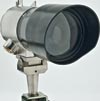
The implementation of a comprehensive fire and gas detection and proactive emergency shutdown (ESD) system solution is essential in ensuring the protection of active plants and associated assets of substantial value, and is invaluable in averting any type of potentially catastrophic failure.

MSA Africa product manager for fixed gas and flame detection, Robbie Taitz, notes that the primary function of an ESD solution is essential to prevent the escalation of a potential catastrophe before it becomes uncontrollable.
“One of the most important aspects of a proactive fire and gas detection/ESD solution is that safety should be at the fundamental core of the system, and should not be viewed merely as a business area requiring minimal insurance compliance. Instead, it should be a system that is installed with the sole purpose of actively identifying and addressing pre-emptive critical failure. The ESD should be a system which allows for emergency shutdown to be carried out independent of human intervention,” he explains.
A competent fire and gas detection/ESD system is vital for any large-scale plant that faces two prevalent dangers, namely flammability and toxicity. Another issue to take into consideration is danger to any human population in the nearby environment. As a result, Taitz notes that the operation implementing the fire and gas detection/ESD must undertake a study to determine precisely what features are required to form part of the solution.
“The ESD solution should feature a detection system that senses a variety of threats, including flammability and toxicity of gases, flames, leaks and ultra-sonic leaks. It is also essential to select products that comply with internationally recognised standards, and that all of the components are properly tested and verified.”
These detectors transfer signals back to the system controller to be processed. “If a sensor is activated, the operator in the control room acknowledges the fault, and a technician will be sent out to evaluate the problem. The detectors have a built-in fault condition indicator which informs the operator whether the warning is only a detector fault, or a serious safety issue.”
According to Taitz, it is important that the safety system functions efficiently in the event of an incident occurring at any point in the plant’s operational lifespan. “Therefore, operations need to purchase safety products that comply with an internationally recognised Safety Integrity Level (SIL) standard. SIL is a measurement of performance required for a safety instrumented function.”
SIL is categorised into four ratings; SIL 1, SIL 2, SIL 3 and SIL 4. SIL 3 & 4 rated products are almost indestructible and are used in applications where safety is vital, such as in space programmes, where any degree of system failure is not tolerated. SIL 3 rated products are highly reliable and are most commonly used in hazardous industries such as oil and gas.”
Taitz stresses the importance of ensuring that an entire fire and gas detection/ESD solution is SIL-rated and not merely certain components. “This defeats the purpose of the safety integrity, as it results in a system that is not a safety integrity system, but simply contains safety integrity components. Without a competent core safety detection system, an ESD solution becomes obsolete.”
In order to ensure that the system in place is as safe as possible, Taitz recommends plotting a gas map of the facility. “This determines the most likely areas where gas will flow if there is a leak. A conservative view is taken of the minimalistic positions that have to be covered with reasonable likelihood of the gas being identified by a detector. In the higher risk areas, there will be a high coverage rate of detectors and, as the risk areas decrease, the level of detection will decrease too.”

MSA Africa supplies a range of fixed sensors for protecting a plant. These include the Ultima OPIR 5 combustible gas detector. This open path infrared instrument monitors and detects methane and propane, as well as other combustible gases. The Ultima OPIR offers dual detection for both small and large gas leaks. The digital display and adjustable mounting arms ensure easy alignment. It also features multiple communication outputs for complete status and control capabilities.
Due to the cost driven nature of local industries, Taitz admits that cheap and inferior products are a major concern. “These substandard products are subsequently placed into hazardous environments, despite failing to meet any compliance standards, and provide no safety guarantee whatsoever. Although the overall cost for a safety integrity system and an ESD solution can prove costly, it is certainly an investment that pays for itself in the long term,” he concludes.
For more information contact MSA Africa, +27 (0)11 610 2600, [email protected], www.msaafrica.co.za

© Technews Publishing (Pty) Ltd. | All Rights Reserved.